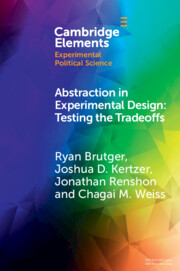12 results
Frequency-based salience of dual meanings in conventional metaphor acquisition: Evidence from toddlers in Urban England
-
- Journal:
- Language and Cognition / Volume 17 / 2025
- Published online by Cambridge University Press:
- 09 January 2025, e8
-
- Article
-
- You have access
- Open access
- HTML
- Export citation

Style and Meaning in Late Antique Art
- Ancients and Moderns on Seeing and Thinking
-
- Published online:
- 15 August 2024
- Print publication:
- 08 August 2024

Abstract Objects
-
- Published online:
- 05 February 2024
- Print publication:
- 29 February 2024
-
- Element
- Export citation

Time, Metaphor, and Language
- A Cognitive Science Perspective
-
- Published online:
- 09 November 2023
- Print publication:
- 23 November 2023
Chapter 2 - The Stance of Enquiry
-
- Book:
- Plato's <i>Charmides</i>
- Published online:
- 20 July 2023
- Print publication:
- 10 August 2023, pp 30-59
-
- Chapter
- Export citation

Abstraction in Experimental Design
- Testing the Tradeoffs
-
- Published online:
- 29 September 2022
- Print publication:
- 27 October 2022
-
- Element
- Export citation
7 - The Abstract
-
- Book:
- Scientific Writing and Publishing
- Published online:
- 14 October 2021
- Print publication:
- 30 September 2021, pp 93-98
-
- Chapter
- Export citation

Geometric Regular Polytopes
-
- Published online:
- 30 January 2020
- Print publication:
- 20 February 2020
24 - Presenting Your Work at a Conference
-
- Book:
- Studying Primates
- Published online:
- 19 September 2019
- Print publication:
- 26 September 2019, pp 313-326
-
- Chapter
- Export citation
22 - Writing a Scientific Report
-
- Book:
- Studying Primates
- Published online:
- 19 September 2019
- Print publication:
- 26 September 2019, pp 271-298
-
- Chapter
- Export citation
Frequency of Manuscript Publication Following Presentation of EMS Abstracts at National Meetings
-
- Journal:
- Prehospital and Disaster Medicine / Volume 29 / Issue 3 / June 2014
- Published online by Cambridge University Press:
- 15 April 2014, pp. 294-298
- Print publication:
- June 2014
-
- Article
- Export citation
Numerical representation in the parietal lobes: Abstract or not abstract?
-
- Journal:
- Behavioral and Brain Sciences / Volume 32 / Issue 3-4 / August 2009
- Published online by Cambridge University Press:
- 27 August 2009, pp. 313-328
-
- Article
- Export citation

